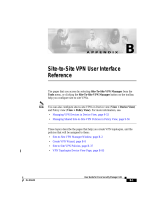
Resolved Issues
•
If you create two Provisioning Jobs to simultaneously provision two VPNs that use a
common set of security devices, only the first Provisioning Job will succeed. The second
Provisioning Job fails and displays an incorrect error message.
Workaround: You can either re-provision the second VPN that failed to provision after
the first VPN’s Provisioning Job is complete, or provision these VPNs, one at a time,
ensuring that the first VPN’s Provisioning Job is complete before you start provisioning
the next one. [PR 544595]
Service Insight
The Junos Space Service Insight application accelerates operational analysis and manages
exposure to known issues. The Junos Space Service Insight application presents the
following new features:
New Features
The Junos Space Service Insight application presents the following new features:
•
Automated EOL analysis—Identifying the devices available for End Of Life (EOL)
reports and providing EOL information for those devices by enabling generation of EOL
reports that provide detailed device EOL information, such as, the number of devices
in the network with EOL parts, EOL announce date, number of EOL announce parts,
End Of Engineering SW date, number of End Of Engineering SW parts, End Of
Engineering HW date, number of End Of Engineering HW parts, End Of Support date,
number of End Of Support parts, top level assembly parts, circuit assembly parts, PSN
numbers, and replacement numbers. This helps ensure that software and devices are
serviceable and you can upgrade and replace equipment that is no longer supported
by Juniper Networks.
•
PBNs for preventive action— Identifying devices with characteristics similar to devices
on which issues were found and displaying Proactive Bug Notifications (PBNs) that
provide information about issues, such as, the condition that triggered the issue,
symptoms of the issue, temporary solutions to the issue, and additional instructions
that users can follow to prevent the issue from occurring on the device. This is a
proactive measure to ensure that users are aware of the known issues that could affect
their network. Users can scan PBNs to display only those devices that are affected by
a particular PBN, flag PBNs to users, assign owners to the PBNs, e-mail the PBNs to
users, and delete them. Users can also list the PBNs that are associated to a particular
device.
•
Notifications— Notifying users about EOL and PBN information arrival and PBN
information matches found for devices on the network. Managing these notifications
and also creating filters that further specify when users must be notified, such as, the
tag value that must match for the associated devices, the serial number or device
name that must be matched, and the words that must or must not match the title of
the PBN that has arrived. Users are allowed to edit notifications, enable or disable
them, copy the attributes of notifications, and delete notifications.
9Copyright © 2010, Juniper Networks, Inc.
Service Insight













